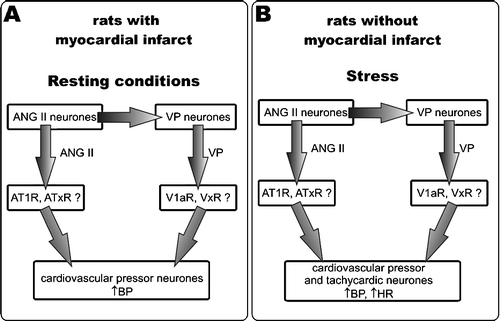Figures & data
Figure 1 Changes in mean arterial blood pressure (MABP) and heart rate during intracerebroventricular (i.c.v.) administration of artificial cerebrospinal fluid (aCSF, control) and angiotensin II (ANG II) in SL and infarcted rats at rest. #Significant changes in MABP when compared with baseline during i.c.v. infusion of ANG II [F(7,56) = 4.823; P < 0.001], *significant difference in MABP changes between i.c.v. infusion of ANG II and aCSF at the corresponding time {interaction between ANG II infarct and aCSF infarct: [F(7,110) = 2.767; P < 0.05], difference between ANG II infarct and aCSF infarct: [F(1,15) = 21.710; P < 0.001]}. n = 8–9 rats per group.
![Figure 1 Changes in mean arterial blood pressure (MABP) and heart rate during intracerebroventricular (i.c.v.) administration of artificial cerebrospinal fluid (aCSF, control) and angiotensin II (ANG II) in SL and infarcted rats at rest. #Significant changes in MABP when compared with baseline during i.c.v. infusion of ANG II [F(7,56) = 4.823; P < 0.001], *significant difference in MABP changes between i.c.v. infusion of ANG II and aCSF at the corresponding time {interaction between ANG II infarct and aCSF infarct: [F(7,110) = 2.767; P < 0.05], difference between ANG II infarct and aCSF infarct: [F(1,15) = 21.710; P < 0.001]}. n = 8–9 rats per group.](/cms/asset/c1e047d9-cca1-4d27-99d9-3b0a6ad49968/ists_a_279482_f0001_b.gif)
Figure 2 Changes in mean arterial blood pressure (MABP) and heart rate during intracerebroventricular (i.c.v.) administration of artificial cerebrospinal fluid (aCSF, control) and infusion of angiotensin II (ANG II) with vasopressin (VP) (ANG II + VP) in sham-ligated and infarcted rats. #Significant change in MABP compared with baseline during i.c.v. infusion of ANG II + VP [F(7,49) = 6.282; P < 0.001], *significant difference in MABP changes between i.c.v. infusion of ANG II + VP and aCSF at the corresponding time {interaction between ANG II + VP infarct and aCSF infarct: [F(7,98) = 4.218; P < 0.001], difference between ANG II + VP infarct and aCSF infarct [(1,14) = 11.315; P < 0.01]}. For ease of comparison changes in MABP during infusion of aCSF in the infarcted and sham-ligated rats are redrawn from . n = 8–9 rats per group.
![Figure 2 Changes in mean arterial blood pressure (MABP) and heart rate during intracerebroventricular (i.c.v.) administration of artificial cerebrospinal fluid (aCSF, control) and infusion of angiotensin II (ANG II) with vasopressin (VP) (ANG II + VP) in sham-ligated and infarcted rats. #Significant change in MABP compared with baseline during i.c.v. infusion of ANG II + VP [F(7,49) = 6.282; P < 0.001], *significant difference in MABP changes between i.c.v. infusion of ANG II + VP and aCSF at the corresponding time {interaction between ANG II + VP infarct and aCSF infarct: [F(7,98) = 4.218; P < 0.001], difference between ANG II + VP infarct and aCSF infarct [(1,14) = 11.315; P < 0.01]}. For ease of comparison changes in MABP during infusion of aCSF in the infarcted and sham-ligated rats are redrawn from Figure 1. n = 8–9 rats per group.](/cms/asset/439c9f98-030d-4ba1-bbb6-e6aef1d49c5a/ists_a_279482_f0002_b.gif)
Figure 3 Changes in mean arterial blood pressure (MABP) and heart rate during intracerebroventricular (i.c.v.) administration of artificial cerebrospinal fluid (aCSF, control) and ANG II with V1a receptor antagonist {d(CH2)5[Tyr(Me)2-Ala-NH29]AVP; V1ANT}in the sham-ligated and the infarcted rats at rest. For ease of comparison changes in MABP during aCSF infusion in the infarcted and the sham-ligated rats are redrawn from . n = 8–9 rats per group.
![Figure 3 Changes in mean arterial blood pressure (MABP) and heart rate during intracerebroventricular (i.c.v.) administration of artificial cerebrospinal fluid (aCSF, control) and ANG II with V1a receptor antagonist {d(CH2)5[Tyr(Me)2-Ala-NH29]AVP; V1ANT}in the sham-ligated and the infarcted rats at rest. For ease of comparison changes in MABP during aCSF infusion in the infarcted and the sham-ligated rats are redrawn from Figure 1. n = 8–9 rats per group.](/cms/asset/936a3139-17ed-4171-988f-e3c689d87f63/ists_a_279482_f0003_b.gif)
Figure 4 Maximum increases in mean arterial blood pressure (MABP) and heart rate evoked by air-jet stress in the infarcted and sham-ligated rats during i.c.v. infusion of artificial cerebrospinal fluid (aCSF), angiotensin II (ANG II), ANG II with vasopressin (VP) and ANG II with VP V1a receptors antagonist {d(CH2)5[Tyr(Me)2-Ala-NH29]AVP; V1ANT}, *significant difference between the corresponding experimental groups, #significant difference between the infarcted and sham-ligated rats (##P < 0.01, #P < 0.05). n = 8–9 rats per group.
![Figure 4 Maximum increases in mean arterial blood pressure (MABP) and heart rate evoked by air-jet stress in the infarcted and sham-ligated rats during i.c.v. infusion of artificial cerebrospinal fluid (aCSF), angiotensin II (ANG II), ANG II with vasopressin (VP) and ANG II with VP V1a receptors antagonist {d(CH2)5[Tyr(Me)2-Ala-NH29]AVP; V1ANT}, *significant difference between the corresponding experimental groups, #significant difference between the infarcted and sham-ligated rats (##P < 0.01, #P < 0.05). n = 8–9 rats per group.](/cms/asset/0997e890-cc93-4235-904b-564e0ab5ff7f/ists_a_279482_f0004_b.gif)
Figure 5 Schematic of cooperation between angiotensin and vasopressin in the central regulation of cardiovascular parameters by angiotensin II (ANG II) and vasopressin (VP) based on present and previous results (Dobruch et al. Citation2005; Cudnoch-Jędrzejewska et al. Citation2007). (A) The myocardial infarct increases involvement of ANG II and VP in central regulation of blood pressure at rest via AT1 and V1a receptors. The present results show that VP is necessary to induce sensitisation to central pressor action of ANG II after a myocardial infarction. ANG II may stimulate the cardiovascular pressor neurones directly and indirectly by increasing release of VP. Cooperative action of these two peptides results in the pressor response. (B) ANG II enhances the pressor effect of an alarming stressor in intact rats. The tachycardic response to the stressor is not altered by separate actions of ANG II or VP but is increased by their cooperative action. The effects exerted by ANG II and VP via AT1 and V1a receptors may be modified by stimulation of other receptors (ATxR and VPxR).

